The NVIDIA GeForce GTX 980 Review: Maxwell Mark 2
by Ryan Smith on September 18, 2014 10:30 PM ESTPower, Temperature, & Noise
As always, last but not least is our look at power, temperature, and noise. Next to price and performance of course, these are some of the most important aspects of a GPU, due in large part to the impact of noise. All things considered, a loud card is undesirable unless there’s a sufficiently good reason – or sufficiently good performance – to ignore the noise.
Having already seen the Maxwell architecture in action with the GTX 750 series, the GTX 980 and its GM204 Maxwell 2 GPU have a very well regarded reputation to live up to. GTX 750 Ti shattered old energy efficiency marks, and we expect much the same of GTX 980. After all, NVIDIA tells us that they can deliver more performance than the GTX 780 Ti for less power than the GTX 680, and that will be no easy feat.
| GeForce GTX 980 Voltages | ||||
| GTX 980 Boost Voltage | GTX 980 Base Voltage | GTX 980 Idle Voltage | ||
| 1.225v | 1.075v | 0.856v | ||
We’ll start as always with voltages, which in this case I think makes for one of the more interesting aspects of GTX 980. Despite the fact that GM204 is a pretty large GPU at 398mm2 and is clocked at over 1.2GHz, NVIDIA is still promoting a TDP of just 165W. One way to curb power consumption is to build a processor wide-and-slow, and these voltage numbers are solid proof that NVIDIA has not done that.
With a load voltage of 1.225v, NVIDIA is driving GM204 as hard (if not harder) than any of the Kepler GPUs. This means that all of NVIDIA’s power optimizations – the key to driving 5.2 billion transistors at under 165W – lie with other architectural optimizations the company has made. Because at over 1.2v, they certainly aren’t deriving any advantages from operating at low voltages.
Next up, let’s take a look at average clockspeeds. As we alluded to earlier, NVIDIA has maintained the familiar 80C default temperature limit for GTX 980 that we saw on all other high-end GPU Boost 2.0 enabled cards. Furthermore as a result of reinvesting most of their efficiency gains into acoustics, what we are going to see is that GTX 980 still throttles. The question then is by how much.
| GeForce GTX 980 Average Clockspeeds | |||
| Max Boost Clock | 1252MHz | ||
| Metro: LL |
1192MHz
|
||
| CoH2 |
1177MHz
|
||
| Bioshock |
1201MHz
|
||
| Battlefield 4 |
1227MHz
|
||
| Crysis 3 |
1227MHz
|
||
| TW: Rome 2 |
1161MHz
|
||
| Thief |
1190MHz
|
||
| GRID 2 |
1151MHz
|
||
| Furmark |
923MHz
|
||
What we find is that while our GTX 980 has an official boost clock of 1216MHz, our sustained benchmarks are often not able to maintain clockspeeds at or above that level. Of our games only Bioshock Infinite, Crysis 3, and Battlefield 4 maintain an average clockspeed over 1200MHz, with everything else falling to between 1151MHz and 1192MHz. This still ends up being above NVIDIA’s base clockspeed of 1126MHz – by nearly 100MHz at times – but it’s clear that unlike our 700 series cards NVIDIA is much more aggressively rating their boost clock. The GTX 980’s performance is still spectacular even if it doesn’t get to run over 1.2GHz all of the time, but I would argue that the boost clock metric is less useful this time around if it’s going to overestimate clockspeeds rather than underestimate. (ed: always underpromise and overdeliver)
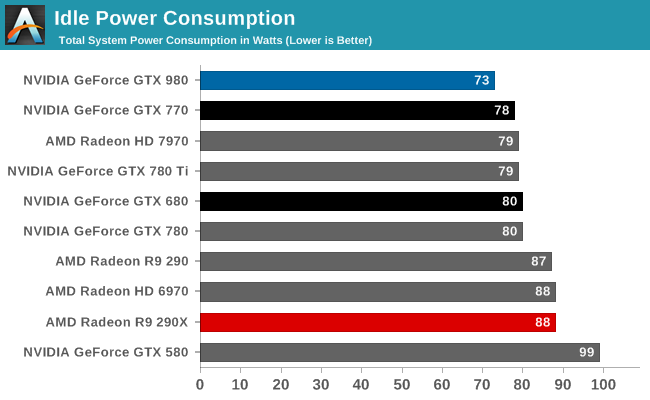
Starting as always with idle power consumption, while NVIDIA is not quoting specific power numbers it’s clear that the company’s energy efficiency efforts have been invested in idle power consumption as well as load power consumption. At 73W idle at the wall, our testbed equipped with the GTX 980 draws several watts less than any other high-end card, including the GK104 based GTX 770 and even AMD’s cards. In desktops this isn’t going to make much of a difference, but in laptops with always-on dGPUs this would be helpful in freeing up battery life.

Our first load power test is our gaming test, with Crysis 3. Because we measure from the wall, this test means we’re seeing GPU power consumption as well as CPU power consumption, which means high performance cards will drive up the system power consumption numbers merely by giving the CPU more work to do. This is exactly what happens in the case of the GTX 980; at 304W it’s between the GK104 based GTX 680 and GTX 770, however it’s also delivering 30% better framerates. Accordingly the power consumption of the GTX 980 itself should be lower than either card, but we would not see it in a system power measurement.
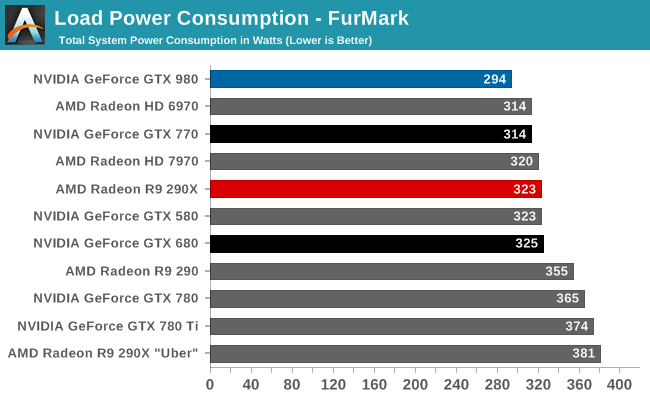
For that reason, when looking at recent generation cards implementing GPU Boost 2.0 or PowerTune 3, we prefer to turn to FurMark as it essentially nullifies the power consumption impact of the CPU. In this case we can clearly see what NVIDIA is promising: GTX 980’s power consumption is lower than everything else on the board, and noticeably so. With 294W at the wall, it’s 20W less than GTX 770, 29W less than 290X, and some 80W less than the previous NVIDIA flagship, GTX 780 Ti. At these power levels NVIDIA is essentially drawing the power of a midrange class card, but with chart-topping performance.
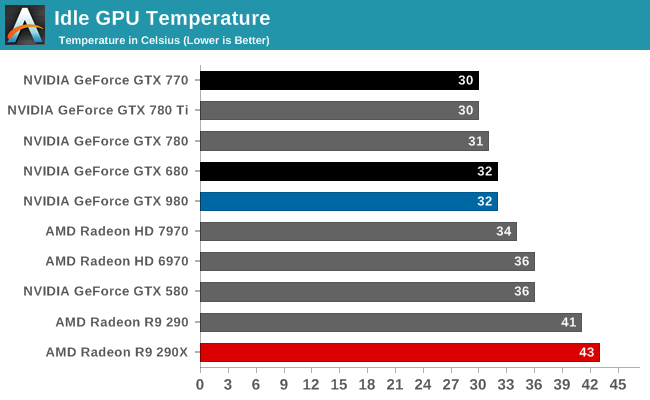
Moving on to temperatures, at idle we see nothing remarkable. All of these well-designed, low idle power designs are going to idle in the low 30s, especially since they’re not more than a few degrees over room temperature.

With an 80C throttle point in place for the GTX 980, it’s here where we see the card top out at. The fact that we’re hitting 80C is the reason why the card is exhibiting clockspeed throttling as we saw earlier. NVIDIA’s chosen fan curve is tuned for noise over temperature, so it’s letting the GPU reach its temperature throttle point rather than ramp up the fan (and the noise) too much.
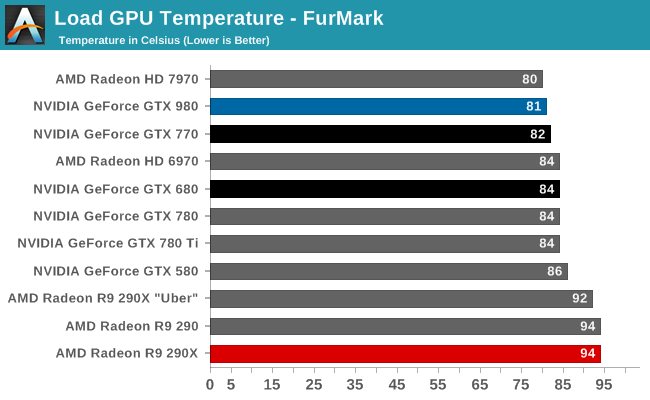
Once again we see the 80C throttle in action. Like all GPU Boost 2.0 NVIDIA cards, NVIDIA makes sure their products aren’t going to get well over 80C no matter the workload.
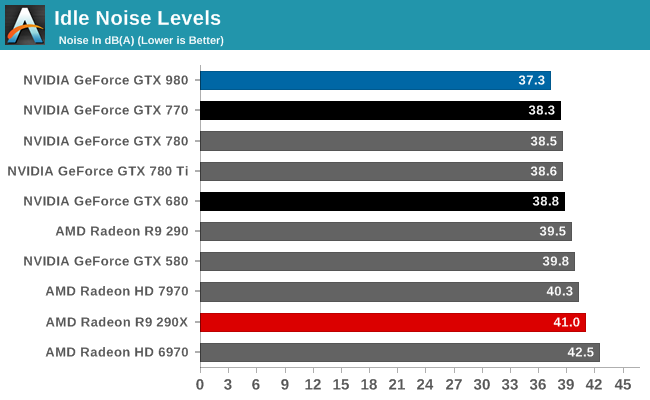
Last but not least we have our noise results. Right off the bat the GTX 980 is looking strong; even with the shared heritage of the cooler with the GTX 780 series, the GTX 980 is slightly but measurably quieter at idle than any other high-end NVIDIA or AMD card. At 37.3dB, the GTX 980 comes very close to being silent compared to the rest of the system.

Our Crysis 3 load noise testing showcases the full benefits of the GTX 980’s well-built blower in action. GTX 980 doesn’t perform appreciably better than the GTX Titan cooler equipped GTX 770 and GTX 780, but then again GTX 980 is also not using quite as advanced of a cooler (forgoing the vapor chamber). Still, this is enough to edge ahead of the GTX 770 by 0.1dB, technically making it the quietest video card in this roundup. Though for all practical purposes, it’s better to consider it tied with the GTX 770.

FurMark noise testing on the other hand drives a wedge between the GTX 980 and all other cards, and it’s in the GTX 980’s favor. Despite the similar noise performance between various NVIDIA cards under Crysis 3, under our maximum, pathological workload of FurMark the GTX 980 pulls ahead thanks to its 165W TDP. At the end of the day its lower TDP limit means that the GTX 980 never has too much heat to dissipate, and as a result it never gets too loud. In fact it can’t. 48.1dB is as loud as the GTX 980 can get, which is why the GTX 980’s cooler and overall build are so impressive. There are open air cooled cards that now underperform the GTX 980 that can’t hit these low of noise levels, never mind the other cards with blowers.
Between the GTX Titan and its derivatives and now GTX 980, NVIDIA has spent quite a bit of time and effort on building a better blower, and with their latest effort it really shows. All things considered we prefer blower type coolers for their heat exhaustion benefits – just install it and go, there’s almost no need to worry about what the chassis cooling can do – and with NVIDIA’s efforts to build such a solid cooler for a moderately powered card, the end result is a card with a cooler that offers all the benefits of a blower with the acoustics that can rival and open air cooler. It’s a really good design and one of our favorite aspects of GTX Titan, its derivatives, and now GTX 980.










274 Comments
View All Comments
Frenetic Pony - Friday, September 19, 2014 - link
This is the most likely thing to happen, as the transition to 14nm takes place for intel over the next 6 months those 22nm fabs will sit empty. They could sell capacity at a similar process to TSMC's latest while keeping their advantage at the same time.nlasky - Friday, September 19, 2014 - link
Intel uses the same Fabs to produce 14nm as it does to produce 22nmlefty2 - Friday, September 19, 2014 - link
I can see Nvidia switching to Intel's 14nm, however Intel charges a lot more than TSMC for it's foundry services (because they want to maintain their high margins). That would mean it's only economical for the high end cardsSeanJ76 - Friday, September 19, 2014 - link
What a joke!!!! 980GTX doesn't even beat the previous year's 780ti??? LOL!! Think I'll hold on to my 770 SC ACX Sli that EVGA just sent me for free!!Margalus - Friday, September 19, 2014 - link
uhh, what review were you looking at? or are you dyslexic and mixed up the results between the two cards?eanazag - Friday, September 19, 2014 - link
Nvidia would get twice as many GPUs per wafer on a 14nm process than 28nm. Maxwell at 14nm would blow Intel integrated and AMD out of the water in performance and power usage.That simply isn't the reality. Samsung has better than 28nm processes also. This type of partnership would work well for Nvidia and AMD to partner with Samsung on their fabs. It makes more sense than Intel because Intel views Nvidia as a threat and competitor. There are reasons GPUs are still on 28nm and it is beyond process availability.
astroidea - Friday, September 19, 2014 - link
They'd actually get four times more since you have to considered the squared area. 14^2*4=28^2emn13 - Saturday, September 20, 2014 - link
Unfortunately, that's not how it works. A 14nm process isn't simply a 28nm process scaled by 0.5; different parts are scaled differently, and so the overall die area savings aren't that simple to compute.In a sense, the concept of a "14nm" process is almost a bit of a marketing term, since various components may still be much larger than 14nm. And of course, the same holds for TSMC's 28nm process... so a true comparison would require more knowledge that you or I have, I'm sure :-) - I'm not sure if intel even releases the precise technical details of how things are scaled in the first place.
bernstein - Friday, September 19, 2014 - link
no because intel is using their 22nm for haswell parts... the cpu transition ends in a year with the broadwell xeon-ep... at which point almost all the fabs will either be upgraded or upgrading to 14nm and the rest used to produce chipsets and other secondary die'snlasky - Saturday, September 20, 2014 - link
yes but they use the same fabs for both processes